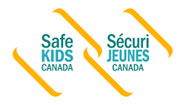Q. Can my baby get hurt using a baby jumper?
Baby jumpers are seats that allow babies to bounce up and down. The jumper is hung from the top of a doorframe with a clamp. Parent usually use a jumper as a way to entertain their babies while giving them a few minutes of "hands-free" time. Currently there are no safety standards for jumpers in North America. Jumpers are usually safe if they are installed and used properly. However, like many other children's products there are risks associated with their misuse. Children have been injured in jumpers when they are not used as intended, for example as a baby swing or a baby carrier. Babies have also fallen when the clamp is not fixed securely to the doorway or when the jumper strap breaks. Some babies have been hurt when they fell out of the jumper seat while trying to stand or when jumping excessively.
Q. At what age can my baby use a jumper?
Your baby should be able to sit up with his or her head upright before you use a jumper. This developmental milestone is usually reached between 6 and 8 months of age. You should stop using the jumper when your baby can stand independently.
Top
Q. How can I install my jumper safely? Always read the instruction manual before installing or using a jumper. In order for the jumper's wall clamp to be securely fastened to the doorframe there are two important requirements:
- The thickness of the wall above the doorframe, where the clamp is attached, should meet the manufacturer's specification. Some older homes may have walls that are too thick to fit the clamp, or walls may be too thin resulting in a loose grip.
- To prevent the clamp from slipping, jumpers require a secure doorway trim. The doorframe trim should be at least half an inch (1/2") thick at the top.
If you use a baby jumper, keep these safety tips in mind:
- Choose a jumper that is appropriate for your baby's height, weight and age. Check the manufacturer's instructions.
- Make sure the jumper is assembled, installed and used according to manufacturer's instructions.
- If buying or borrowing a second hand jumper, be sure that the jumper has all its parts and has not been recalled. To install and use a jumper safely, you will need a copy of the instruction manual. Contact the manufacturer for a copy of the instruction manual.
- Jumpers are intended for use with doorways only. Use the jumper on a doorframe that can support the jumper properly. Check manufacturer's instructions for doorway specifications.
- Before you place your baby in the jumper, check if the clamps and straps are properly secured by pulling down on the jumper. Take down the jumper after every use. Never move the jumper while your baby is in it.
- Position the jumper in the middle of the doorway so that your baby is away from the sharp sides of the doorframe.
- Make sure you install the jumper away from stairs.
- Limit your baby's jumping time for 10 to15 minutes at a time.
- Jumpers should not be used as a swing or a baby carrier. Teach siblings not to push or pull the baby while in the jumper to prevent accidental bumping.
- Do not leave your baby unattended while in the jumper. You should be able to watch your baby at all times while he or she is in the jumper.
| Page published on 2006-08-22 |
|
|



